Curiosity and perforator
The rover Curiosity completes the 2012 Mars research cycle. As a result of movement in recent days, they were examined by a new type of surface, which was observed from the satellite. The rover has chosen a target for the upcoming use of its drill and a sample of solid rock. The drilling process itself will begin in 2013, and the rover team is preparing to go to the Christmas holidays.

The site, called Glenelg, was chosen as an intermediate goal of the study, before the implementation of the main task - the study of Mount Sharp (Eolida). Glenelg seemed interesting to scientists because a small section of Gale's crater had three types of different surfaces. One segment bore traces of an alluvial formation, i.e. was formed under the influence of water - it was made landing. The second one was determined from the satellite as a very solid type of soil with a high degree of thermal inertia inherent in rock formations - the rover stopped there now. The third type of surface is much older than the previous two. This can be seen in a much larger number of small meteorite craters on its surface. (Read more about the geology of the Gale crater ).

The site, which had a hard surface and high thermal inertia, is a lowland called Yellowknife Bay. Yellowknife is a town in Canada from which many geological expeditions of American geologists began, and the landing site was named after him. "Yellowknife Bay" got its name from what looked like a dried up body of water.

(“Reservoir” on the lower left, bluish horizontal strip in the center - basalt sands)
The descent began there in September, but Curiosity was delayed for a long time in the area of Rocknest
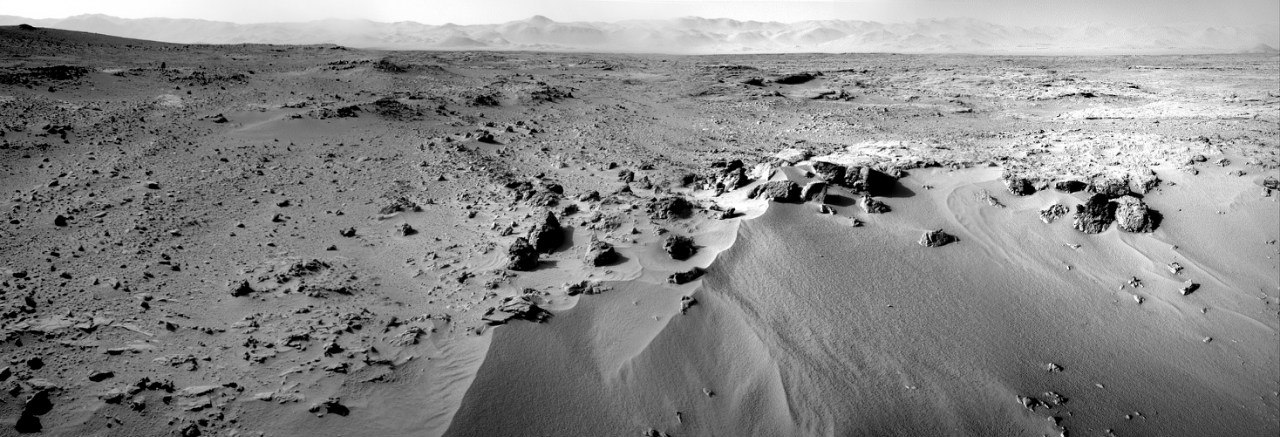
')
There he excavated, explored the Martian sand and tested all his scientific instruments on it. I also made my beautiful self-portrait there (by the way, there was added an animation of the motion of the manipulator, where you can see the secret reception with the “disappeared” hand). Finally, after the studies with the main analytical tools CheMin and SAM were completed, the rover moved on.
After 20 meters he stopped again. And lingered for a week. This time he took a comfortable position to carefully capture the Yellowknife Bay.

(a good selection of panoramas )
At the same time, the purpose for the first application of the drill was previously named. The point was called Point Lake.
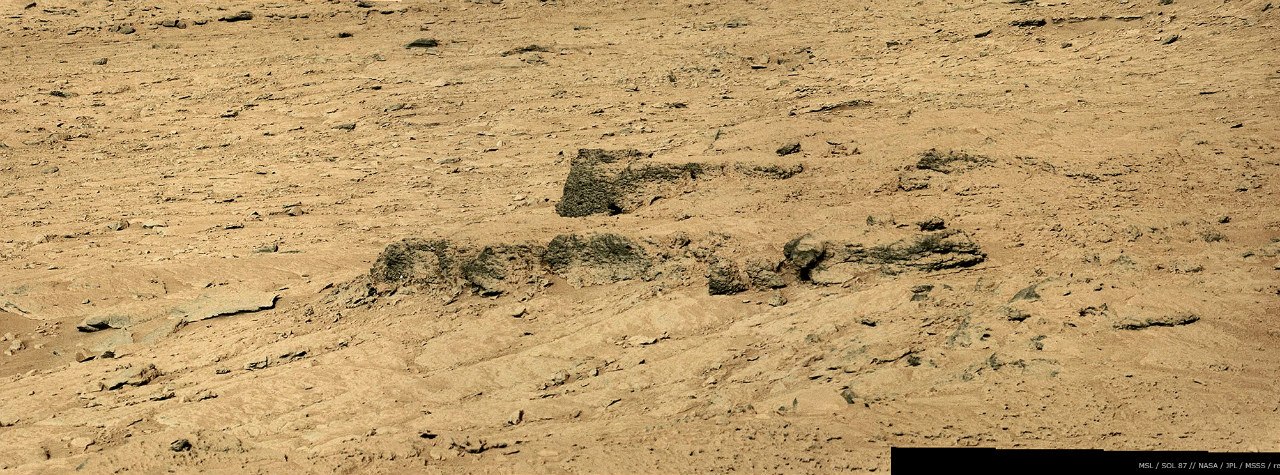
About the drill must be told separately.
Partially tool repeats ordinary household punch. Works on the same principle. Only if, in the case of construction work, the crushed wall material is required to be thrown away so as not to hinder the rotation of the drill, is this powder interesting for Curiosity. Therefore, to obtain it, a special device is provided.

The drill rotates inside the sleeve, into which the powder resulting from the drilling of the rock falls. Thanks to the spiral grooves of the drill, the powder moves inside the sleeve and into the double chamber. From the chamber, the recruited rock is brought out and enters the tube of the CHIMRA device ( visible from the left ).

I already told about CHIMRA when it was a question of the first soil fences with a ladle. But you can repeat a little. This device in the "tower" (turret) manipulator. Its purpose is to screen crushed Martian rock to prepare the sample for loading into the internal devices of the rover.
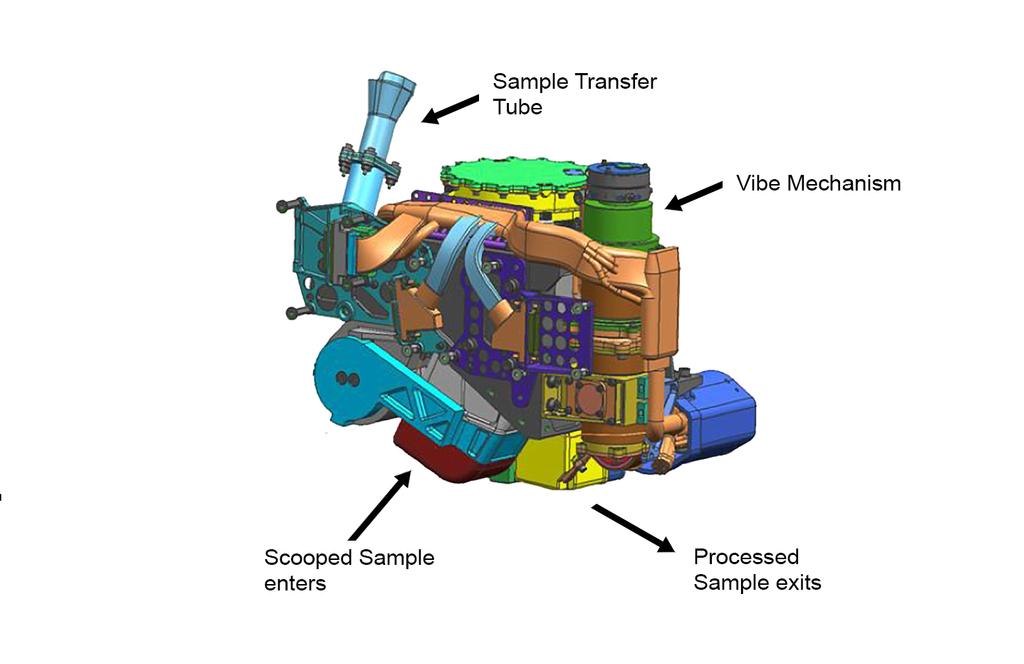
CheMin requires a powder with a grain size of not more than 150 microns. SAM is less demanding, it is suitable for grains up to 1 mm. In order to prepare both those and other samples requires a lot of effort and design engineers, and the operators of the rover.

The sifted sample gets inside, through the funnels of the grouser, which at other times are closed with lids.

The feature of the device of the drill, causes a very careful process of selecting a suitable site and the drilling itself.
With excessively intensive penetration into the ground, the sleeve can easily become clogged. At home, you can easily pull the drill out of the hole, and get rid of excess chips, and on Mars, this case will be very problematic.
If the drill meets an overly soft area of rock or even a cavity, a sharp leap forward could generally damage the drill or manipulator servos. For insurance against such an accident, on the sides of the drill are two stops, which will protect against excessive jerks and bumps.

Another important factor is the displacement of the drilling facility or the rover itself. If the sample is not securely fixed, and the rover does not stand on a horizontal surface, and the coupling with the ground of its wheels is not reliable, then the pressure may cause displacement and changes in the angle of the hole. If this moment is not determined, then the drill or drill may be damaged, which again will be very regrettable, in conditions of another planet.
The rover has spare drills, but there is only one drill, and it was calculated for at least 20 holes made. It can do more if NASA is very scrupulous in the work.

( Bottom left - one of two canisters with spare drills )
Curiously, the most dangerous find for the Curiosity drill would be liquid. Many are still confident that the rover is looking for water, and even the "original" jokes about oil cannot be avoided when the news comes "The United States has begun to drill Mars." At the same time, any liquid will turn the soil into dirt, which will irreversibly contaminate the internal cavity of the drill or CHIMRA. Even if the holes are not completely blocked, the stuck dirt will constantly affect the purity of the results of the study of all subsequent samples.
Liquid water on Mars, in the crater of Gale should not be. At least at a depth of 5 cm, which the drill is taken. But some minerals, including ancient clay, which NASA wants to find, may contain water in a bound state. As a result, an increase in pressure or temperature may result in the release of a small amount of water. To prevent this from happening, before making a decision to launch a drill, scientists will conduct a full-scale analysis of the sample.
Just near the first candidate now and Curiosity has stopped. NASA ignored Point Lake, the rover moved further along the bay in search of an interesting site, and found it in a few days.
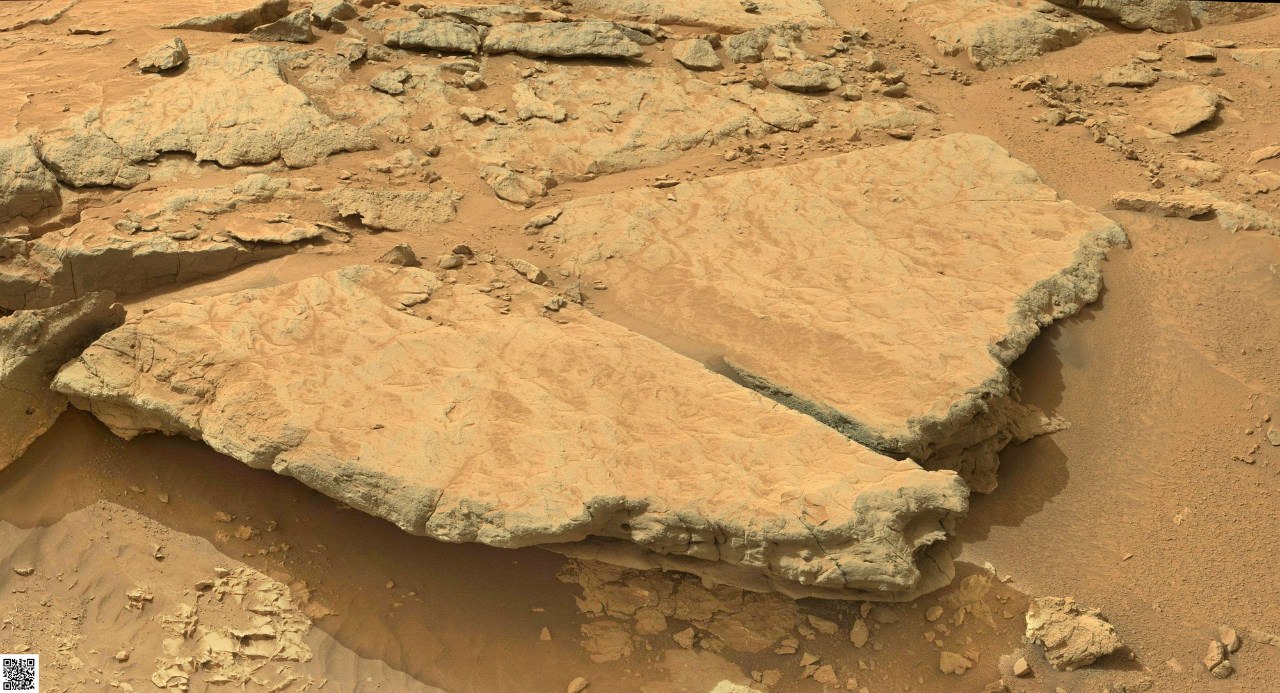
Formats more
The first impression is that it is some kind of sedimentary, and not a volcanic rock. So that her research may be much more promising from the point of view of the detection of organic matter. In clay, hydrocarbons would have been preserved better, but there can be very interesting finds here.
According to NASA, the drilling process itself will begin after the New Year (or Christmas, it's hard to say what “after the holidays” means, let's hope that they don't take two weeks from them). The drilling process itself lasts from 1 to 2 months. Such a long period is due precisely to the reasons described above: a long process of analyzing a candidate, slow drilling, constant monitoring of the position of the drill, the rover, and the stone.
In the meantime, the rover chose its target and moved along the bottom of the “bay”, they found a lot of interesting objects for research.
One gem, even geologists comment with the words “I hope Cutiosity is not going to look into it, otherwise I saw something similar in the film ...”
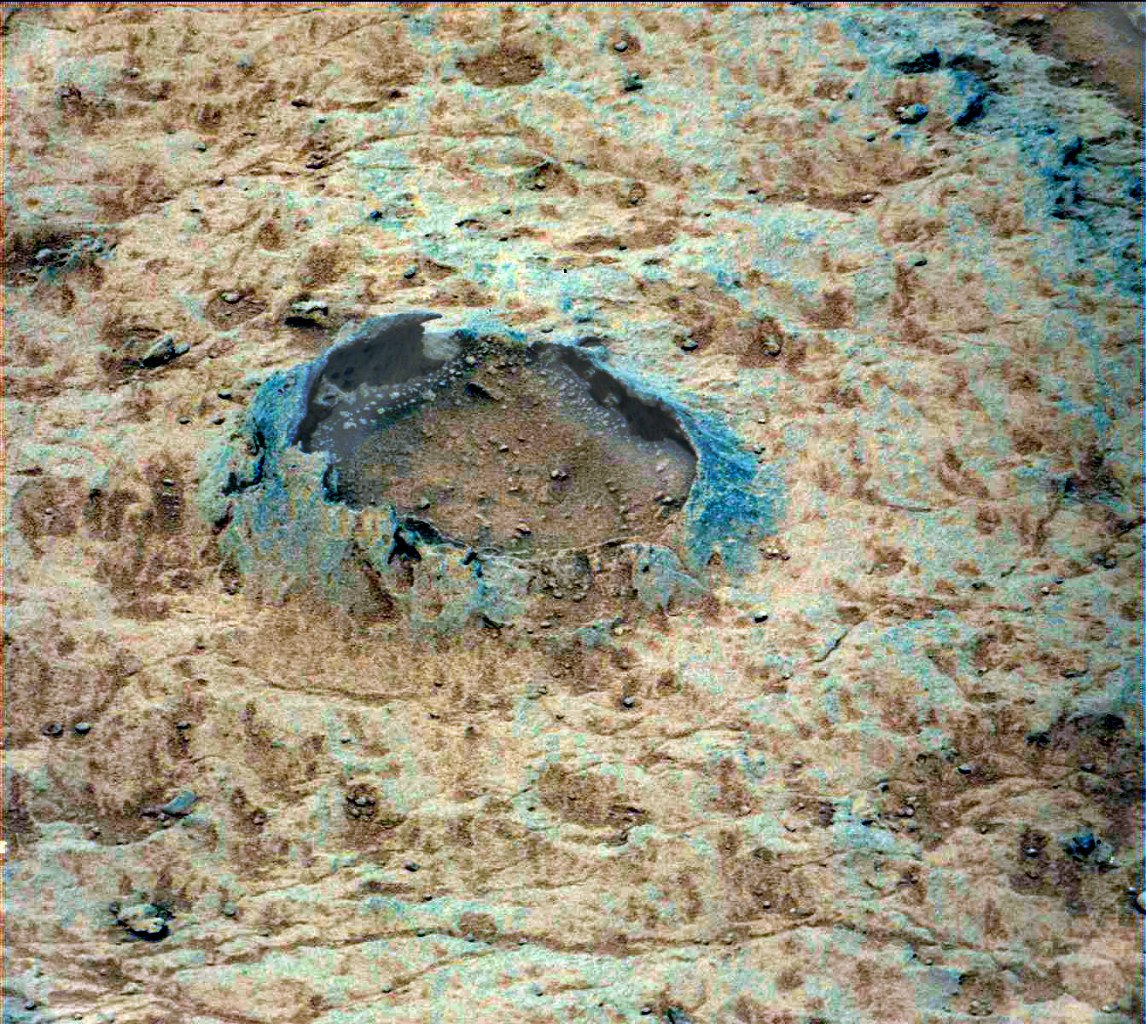
( false color for more detail )
Such bubbles, in some cases resembling hatching eggs, began to occur only when the rover approached the “shore” of the “bay”. At the bottom, another surprise was waiting for him.

Stones with white veins are often found on Earth. Such layers occur when the underlying rock cracks and cracks are filled with another mineral. Most often this happens under the influence of water. Given that most of the geological history, rich in liquid water, is associated with the formation of sulfates, this white mineral may turn out to be gypsum (CaSO4 • 2H2O). Since gypsum is rich in water, its presence can be indirectly determined by a DAN device that scans the soil under Curiosity for hydrogen content.
The form of cracks allows geologists to assume that these are cracks of syneresis . This is a special form of cracks, which occurs at the bottom of water bodies not as a result of drying, but as a result of changes in the degree of salinity of the water. If you take courage and continue further reflections on the history of this reservoir, you can recall that the change of geological eras from Noachian to Hesperides is characterized by saturation of Martian water with sulfur salts and chlorine due to volcanic eruptions. However, the hypothesis that this “gulf” - three billion years seems too incredible.
The same veins are visible on the stone, which will be drilled, so that soon we will have rich information about the geology of this place.

( false color )
UPD. Still, Curiosity - unpredictable girl. She examined the stone and went on. Perhaps all the same will return to Point Lake, but not a fact.


The site, called Glenelg, was chosen as an intermediate goal of the study, before the implementation of the main task - the study of Mount Sharp (Eolida). Glenelg seemed interesting to scientists because a small section of Gale's crater had three types of different surfaces. One segment bore traces of an alluvial formation, i.e. was formed under the influence of water - it was made landing. The second one was determined from the satellite as a very solid type of soil with a high degree of thermal inertia inherent in rock formations - the rover stopped there now. The third type of surface is much older than the previous two. This can be seen in a much larger number of small meteorite craters on its surface. (Read more about the geology of the Gale crater ).

The site, which had a hard surface and high thermal inertia, is a lowland called Yellowknife Bay. Yellowknife is a town in Canada from which many geological expeditions of American geologists began, and the landing site was named after him. "Yellowknife Bay" got its name from what looked like a dried up body of water.

(“Reservoir” on the lower left, bluish horizontal strip in the center - basalt sands)
The descent began there in September, but Curiosity was delayed for a long time in the area of Rocknest

')
There he excavated, explored the Martian sand and tested all his scientific instruments on it. I also made my beautiful self-portrait there (by the way, there was added an animation of the motion of the manipulator, where you can see the secret reception with the “disappeared” hand). Finally, after the studies with the main analytical tools CheMin and SAM were completed, the rover moved on.
After 20 meters he stopped again. And lingered for a week. This time he took a comfortable position to carefully capture the Yellowknife Bay.

(a good selection of panoramas )
At the same time, the purpose for the first application of the drill was previously named. The point was called Point Lake.

About the drill must be told separately.
Partially tool repeats ordinary household punch. Works on the same principle. Only if, in the case of construction work, the crushed wall material is required to be thrown away so as not to hinder the rotation of the drill, is this powder interesting for Curiosity. Therefore, to obtain it, a special device is provided.

The drill rotates inside the sleeve, into which the powder resulting from the drilling of the rock falls. Thanks to the spiral grooves of the drill, the powder moves inside the sleeve and into the double chamber. From the chamber, the recruited rock is brought out and enters the tube of the CHIMRA device ( visible from the left ).

I already told about CHIMRA when it was a question of the first soil fences with a ladle. But you can repeat a little. This device in the "tower" (turret) manipulator. Its purpose is to screen crushed Martian rock to prepare the sample for loading into the internal devices of the rover.

CheMin requires a powder with a grain size of not more than 150 microns. SAM is less demanding, it is suitable for grains up to 1 mm. In order to prepare both those and other samples requires a lot of effort and design engineers, and the operators of the rover.

The sifted sample gets inside, through the funnels of the grouser, which at other times are closed with lids.

The feature of the device of the drill, causes a very careful process of selecting a suitable site and the drilling itself.
With excessively intensive penetration into the ground, the sleeve can easily become clogged. At home, you can easily pull the drill out of the hole, and get rid of excess chips, and on Mars, this case will be very problematic.
If the drill meets an overly soft area of rock or even a cavity, a sharp leap forward could generally damage the drill or manipulator servos. For insurance against such an accident, on the sides of the drill are two stops, which will protect against excessive jerks and bumps.

Another important factor is the displacement of the drilling facility or the rover itself. If the sample is not securely fixed, and the rover does not stand on a horizontal surface, and the coupling with the ground of its wheels is not reliable, then the pressure may cause displacement and changes in the angle of the hole. If this moment is not determined, then the drill or drill may be damaged, which again will be very regrettable, in conditions of another planet.
The rover has spare drills, but there is only one drill, and it was calculated for at least 20 holes made. It can do more if NASA is very scrupulous in the work.

( Bottom left - one of two canisters with spare drills )
Curiously, the most dangerous find for the Curiosity drill would be liquid. Many are still confident that the rover is looking for water, and even the "original" jokes about oil cannot be avoided when the news comes "The United States has begun to drill Mars." At the same time, any liquid will turn the soil into dirt, which will irreversibly contaminate the internal cavity of the drill or CHIMRA. Even if the holes are not completely blocked, the stuck dirt will constantly affect the purity of the results of the study of all subsequent samples.
Liquid water on Mars, in the crater of Gale should not be. At least at a depth of 5 cm, which the drill is taken. But some minerals, including ancient clay, which NASA wants to find, may contain water in a bound state. As a result, an increase in pressure or temperature may result in the release of a small amount of water. To prevent this from happening, before making a decision to launch a drill, scientists will conduct a full-scale analysis of the sample.
Just near the first candidate now and Curiosity has stopped. NASA ignored Point Lake, the rover moved further along the bay in search of an interesting site, and found it in a few days.

Formats more
The first impression is that it is some kind of sedimentary, and not a volcanic rock. So that her research may be much more promising from the point of view of the detection of organic matter. In clay, hydrocarbons would have been preserved better, but there can be very interesting finds here.
According to NASA, the drilling process itself will begin after the New Year (or Christmas, it's hard to say what “after the holidays” means, let's hope that they don't take two weeks from them). The drilling process itself lasts from 1 to 2 months. Such a long period is due precisely to the reasons described above: a long process of analyzing a candidate, slow drilling, constant monitoring of the position of the drill, the rover, and the stone.
In the meantime, the rover chose its target and moved along the bottom of the “bay”, they found a lot of interesting objects for research.
One gem, even geologists comment with the words “I hope Cutiosity is not going to look into it, otherwise I saw something similar in the film ...”

( false color for more detail )
Such bubbles, in some cases resembling hatching eggs, began to occur only when the rover approached the “shore” of the “bay”. At the bottom, another surprise was waiting for him.

Stones with white veins are often found on Earth. Such layers occur when the underlying rock cracks and cracks are filled with another mineral. Most often this happens under the influence of water. Given that most of the geological history, rich in liquid water, is associated with the formation of sulfates, this white mineral may turn out to be gypsum (CaSO4 • 2H2O). Since gypsum is rich in water, its presence can be indirectly determined by a DAN device that scans the soil under Curiosity for hydrogen content.
The form of cracks allows geologists to assume that these are cracks of syneresis . This is a special form of cracks, which occurs at the bottom of water bodies not as a result of drying, but as a result of changes in the degree of salinity of the water. If you take courage and continue further reflections on the history of this reservoir, you can recall that the change of geological eras from Noachian to Hesperides is characterized by saturation of Martian water with sulfur salts and chlorine due to volcanic eruptions. However, the hypothesis that this “gulf” - three billion years seems too incredible.
The same veins are visible on the stone, which will be drilled, so that soon we will have rich information about the geology of this place.

( false color )
UPD. Still, Curiosity - unpredictable girl. She examined the stone and went on. Perhaps all the same will return to Point Lake, but not a fact.

Source: https://habr.com/ru/post/163119/
All Articles